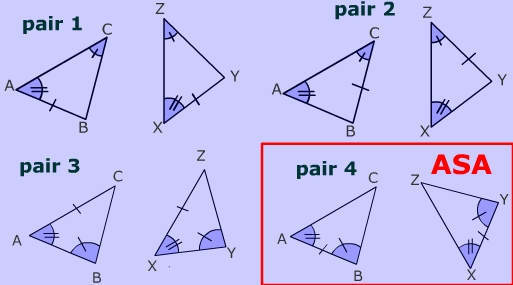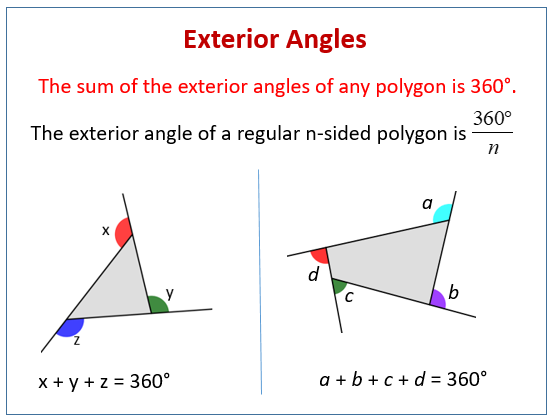The ASA Postulate was contributed by Thales of Miletus Greek. What is the Angle-Side-Angle Postulate for Triangle Congruence.
 Angle Side Angle Postulate For Proving Congruent Triangles Examples Powerpoints This Postulate States
Angle Side Angle Postulate For Proving Congruent Triangles Examples Powerpoints This Postulate States
The ASS Postulate does not exist because an angle and two sides does not guarantee that two triangles are congruent.
Angle side angle postulate. The postulate states that two triangles are similar if they have two corresponding angles that are congruent or equal in measure. Side-Angle-Side SAS Similarity Postulate. Angle-Angle-Side Postulate AAS The AAS Postulate says that if two angles and the non-included side of one triangle are congruent to two angles and the non-included side of a second triangle then the triangles are congruent.
Angle side angle postulate ASA - If two angles and the included side of a triangle are congruent to two angles and the included side of another triangle then the two triangles are congruent by angle-side-angle postulate. This is very similar to the ASA Postulate above because it also has two angles and a side. The Side-Angle-Side postulate is just one of many postulates you can use to show two triangles are congruent.
The SAS rule states that. An included angle is an angle formed by two given sides. Side-Side-Side SSS Similarity Postulate.
Angle-Side-Angle Postulate ASA The ASA Postulate says that if two angles and the included side of one triangle are congruent to two angles and the included side of a second triangle then the triangles are congruent. If two pairs of angles of two triangles are equal in measurement and the included sides are equal in length then the triangles are congruent. Lets say you have one triangle with angles that are 30 and 50 degrees and the side in between those two angles is 9 cm.
Prove the opposite sides and the opposite angles of a parallelogram are congruent. Angle angle side postulate AAS- If two angles and a non-included side of a triangle are congruent to two angles and the corresponding non-included side of another triangle then the two triangles are congruent by angle angle side postulate. This is why there is no Side Side Angle SSA and there is no Angle Side Side ASS postulate.
Using this postulate we no longer have to show that all three. Side Angle Side Postulate The SAS Postulate tells us If two sides and the included angle of a triangle are congruent to two sides and the included angle of another triangle then the two triangles are congruent. If two sides and the included angle of one triangle are equal to two sides and included angle of another triangle then the triangles are congruent.
If two triangles have two congruent sides and a congruent non included angle then triangles are NOT NECESSARILLY congruent. If two angles and the non-included side of one triangle are congruent to the corresponding parts of another triangle the triangles are congruent. The AAS Theorem says.
ABCD is a parallelogram. We can use the Angle Side Angle postulate to prove that the opposite sides and the opposite angles of a parallelogram are congruent Proof 4 Given. If a line through a triangle is parallel to one of the triangles sides the line.
Consider the following two triangles Delta ABC and Delta DEF We are given that begingathered BC EF hfill angle B angle E hfill. The included side is the side between the vertices of the two angles The following figure shows how ASA works. Angle-Angle-Side or AAS Congruence Postulate is a rule which can be used to prove the congruence of two triangles.
B E C F and AC DF Δ ABC Δ DEF by AAS. Worksheet Activity on the Angle Angle Side Postulate Example of Angle Angle Side Proof AAS ABC XYZ. The ASA Angle-Side-Angle postulate states that if two angles and the included side of one triangle are congruent to two angles and the included side of another triangle then the triangles are congruent.
Side-Angle-Side is a rule used to prove whether a given set of triangles are congruent. This tutorial introduces you to the SAS postulate and shows you how to use it. Proving Triangles Congruent by ASA AAS and HL.
In most systems of axioms the three criteria SAS SSS and ASA are established as theorems. B E BC EF and C F ΔABC Δ DEF by ASA. HUG and LAB each have one angle measuring exactly 63.
Angle side angle theorem states that two triangles are congruent if two angles and the included side of one triangle are equal to two angles and the included side of the other triangle. The Angle Angle Side postulate often abbreviated as AAS states that if two angles and the non-included side one triangle are congruent to two angles and the non-included side of another triangle then these two triangles are congruent. If two triangles have a congruent angle and the sides that create this angle are proportional the triangles are similar.
If all three corresponding sides of two triangles form the same proportion the triangles are similar. The Side Angle Side postulate often abbreviated as SAS states that if two sides and the included angle of one triangle are congruent to two sides and the included angle of another triangle then these two triangles are congruent. Notice how it says non-included side meaning you take two consecutive angles and then move on to the next side in either direction.
If we know the sum of all the interior angles of a regular polygon we can obtain the interior angle by dividing the sum by the number of sides. To use this online calculator for Sum of the interior angles of regular polygon enter Number of sides n and hit the calculate button.
 Exterior Angles Of Polygons Examples Solutions Videos Worksheets Activities
Exterior Angles Of Polygons Examples Solutions Videos Worksheets Activities
04 nov 2019 given an integer n the task is to find the sum of interior angles of an n sided polygon.

Formula for interior angle of a polygon. The interior angle of regular polygon can be defined as an angle inside a shape and calculated by dividing the sum of all interior angles by the number of congruent sides of a regular polygon and is represented as In n-2180n or Interior angle of regular polygon Number of sides-2180Number of sides. N 2 180. Interior angle of a polygon sum of interior angles number of sides.
The sum of the interior angles of a polygon is given by the product of two less than the number of sides of the polygon and the sum of the interior angles of a triangle. If the exterior angle of a polygon is given then the formula to find the interior angle is. A n-2 180 Where A is the sum of all interior angles.
The formula for finding the sum of the measure of the interior angles is n - 2 180. Exterior Angles Sum of Polygons. The sum of the measures of the interior angles of a convex polygon with n sides is.
The interior angles of a polygon are the angles that are inside the shape. If n is the number of sides of a polygon then the formula is given below. Here is how the Sum of the interior angles of regular polygon calculation can be explained with given input values - 540 5-2180.
Posted on January 28 2021 by admin. Formulas for Number of Diagonals in a Polygon. Interior angles of a Regular Polygon 180n 360 n.
Measures of the interior angles of regular and irregular polygons. Sum of interior angles of a polygon formula. The sum of the angles in a polygon is n-2180circ where n.
A regular polygon is a flat shape whose sides are all equal and whose angles are all equal. A polygon is called a REGULAR polygon when all of its sides are of the same length and all of its angles are of the same measure. You can use the same formula S n 2 180 S n - 2 180 to find out how many sides n n a polygon has if you know the value of S S the sum of interior angles.
For an icosagon which is a 20-sided figure that would be. To find the measure of one interior angle we take that formula and divide by the number of sides n. You know the sum of interior angles is 900 900 but you have no idea what the shape is.
The measure of each interior angle of an equiangular n -gon is If you count one exterior angle at each vertex the sum of the measures of the exterior angles of a polygon is. If a polygon has p sides then Sum of interior angles p - 2 180 Sum of Interior Angles of a Regular Polygon and Irregular Polygon. For example the interior angles of a pentagon always add up to 540 no matter if it regular or irregular convex or concave or what size and shape it is.
N - 2 180 n. For example a triangle is a polygon with 3 sides and 3 vertices similarly a quadrilateral is a polygon with 4 vertices and 4 sides. A simple closed figure made up of line segments is known as a polygon.
Interior Angle of a polygon 180 Exterior angle of a polygon. Hence we can say now if a convex polygon has n sides then the sum of its interior angle is given by the following formula. The formula for calculating the size of an interior angle is.
Exterior Angle Sum Property of Polygon - formula Exterior angle of polygon n 3 6 0 o. Polygons are generally classified according to the number of vertices and sides they have. By knowing that the interior angles in a triangle add up to 180 you can calculate the interior angle sum of other.
S n 2 180 This is the angle sum of interior angles of a polygon. What is the measure of each individual angle in a regular icosagon a 20-sided figure. The sum of the measures of the interior angles of a polygon with n sides is n 2180.
Interior angles sum of polygons the angle sum of this polygon for interior angles can be determined on multiplying the. Triangle 3 2 180. Sum Of Interior Angles Of A Polygon.
The interior angles of any polygon always add up to a constant value which depends only on the number of sides. Remember that the sum of the interior angles of a polygon is given by the formula Sum of interior angles 180 n 2 where n the number of sides in the polygon. Interior and exterior angle formulas.
The sum of the interior angles of a polygon is given by the formula. Interior Angle Formula The following formula can be used to calculate the sum of interior angles of any polygon. All the interior angles in a regular polygon are equal.
2 question What is the formula for the sum of the interior angle measures of a polygon. Is the number of sides in the polygon.